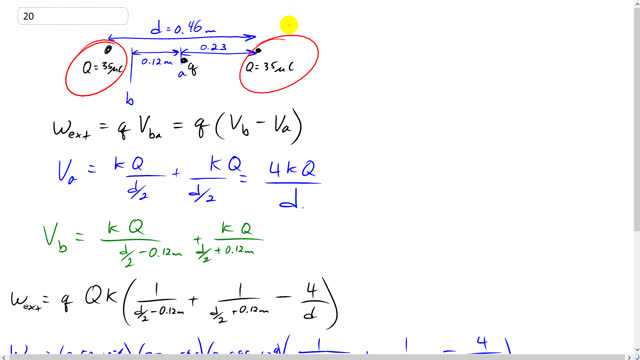
A point charge is placed 46 cm from an identical charge. How much work would be required to move a test charge from a point midway between them to a point 12 cm closer to either of the charges?

In order to watch this solution you need to have a subscription.
This is Giancoli Answers with Mr. Dychko. We have two positive 35 micro coulombs charges here capital Q separated by a distance d is 0.46 meters or 46 centimeters and there's some other charge, a little q midway between them to begin with and then some external force does some external amount of work to move it from this position A where it starts with at midpoint between two big charges and it ends up at some position B, 12 centimeters towards one of the charges and it'll take the same amount of work whether it goes to the left hand charge or the right hand charge because it's… the charges are the same on the left and the right. So the external work that's needed is gonna be this charge q times the potential difference between A and B so that's potential B minus the potential position A And this is the work done by an external force, the work done by the field would be the negative of that and that's what we're used to seeing actually but in this question it's the work done by an external force which is positive q times the potential difference. So we need to find the potential at A and the potential at B and then we'll substitute those results into this formula here. So the potential at A is a… Well adding potentials is a lot easier than adding electric fields because potential is as a scaled quantity, is just a number there's no direction involved so we just add the numbers. So we have k Q over the distance so coulomb’s constant times the charge divided by the distance from the charge to the point of interest and so there is the right hand charge which is… has the charge magnitude of capital Q and this distance to point A is the total separation between charges divided by two and this is actually the same is for the left hand charge, k Q over d over two as well. So each of these can be written as two k Q over d and there's two of them. So, add them together and you get, four kQ over d, is the potential at position A and the potential at position B is k Q times d over two minus 12 centimetres and so that's the potential due to this left hand charge, it's distance is now before d over two subtract away at this 0.12 meters. That's what we have here. And then the potential due to the right hand charge would be k Q over d over two plus 0.12 meters. We have a plus here because we've added this12 centimeters to the d over two distance from this right hand charge to the final end point at point B. And then we substitute for V b and V a in this formula here. So potential that position B is this which I've written here and then minus the potential at position A which I've written here, although I factored out the k and the Q from each of these terms. So that's written outside the brackets here. And then multiplied by a little q here. And then plugging numbers and the charge being moved is a half a micro coulomb, so 0.5 times ten to the minus six coulombs times the charge at each end which is 35 times ten to the minus six coulombs times coulomb’s constant, 8.988 times ten to the nine. And that's one over 0.46 meters over two minus 0.12 meters and then plus one over 0.46 meters over two plus 0.12 meters minus four over the total separation of 0.46 meters. And this gives 0.51 joules. So the external force will have to do a positive amount of work of 0.51 joules to move from point A to Point B.
Why do we make them 2KQ/(d/2) + 2KQ/(d/2)? Why not KQ/(d/2) + KQ/(d/2)? Where does the 2 come from?